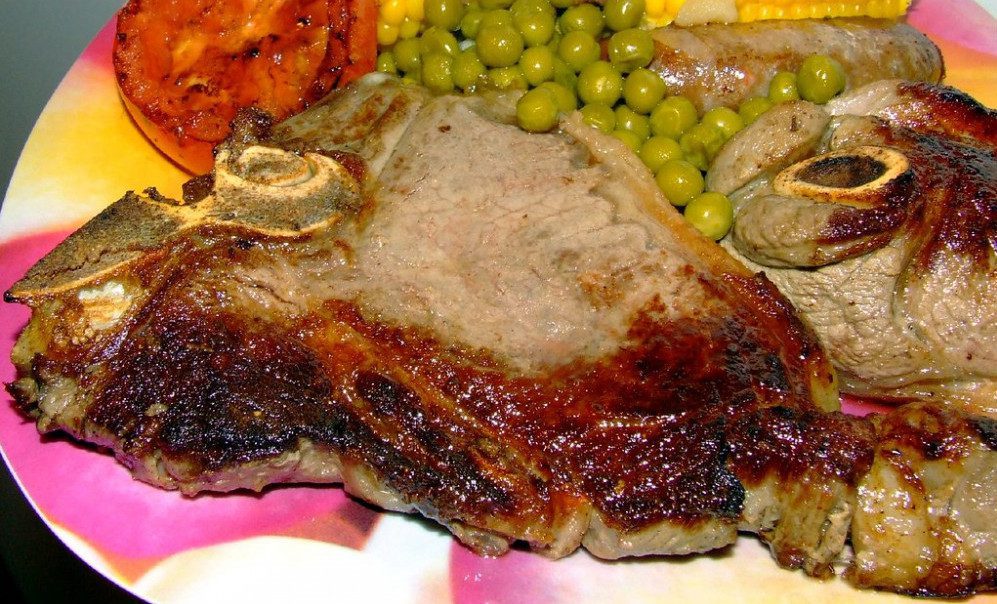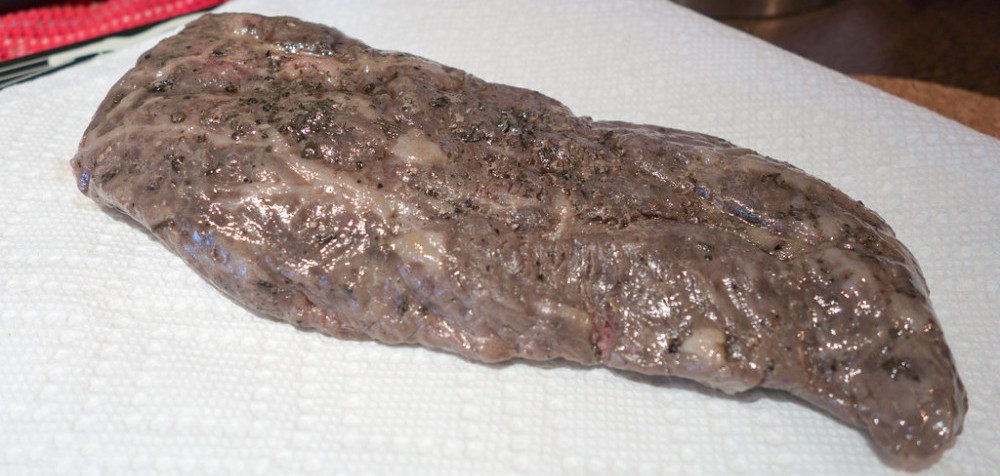Do you have trouble getting that nice brown crust when cooking a steak, and you’re asking, “Why does my steak turn gray when I cook it?”
Actually, a gray-colored steak is a fairly common problem if you don’t follow the correct steps for searing.
Searing is cooking your steak quickly in a hot pan to get a beautiful brown crust. Depending on how you want your steak will depend on how long you need to sear it.
And whether you want your steak to be cooked blue or medium or well-done, your steak doesn’t have to look gray.
There are several things you can do.
So, let’s look at five reasons your steak might look gray after you have cooked it.
Table of Contents
Why Does My Steak Turn Gray When I Cook It?
The main reason your steak looks gray after you have cooked it is you are steaming your meat instead of searing it. Gray happens when your pan isn’t hot enough, or your steak has too much moisture when it hits the pan. Other factors include starting with cold meat, using the wrong kind of oil, or having a pan that heats unevenly.
1. Your Pan Isn’t Hot Enough
One of the main reasons your steak will turn gray is you aren’t searing it.
To sear, you need a hot pan (and oil) or grill.
When you cook a steak in a hot pan or grill, something begins to happen. It’s called the Maillard (pronounced My-yar) Reaction.
The Maillard Reaction begins when the temperature is around 285°F (140°C). It adds flavor to the steak and changes the texture and color of the outside of the meat.
I found it interesting that the Maillard Reaction is a chemical reaction between an amino acid and a reducing sugar.
But how can that be? There isn’t sugar in steak, is there?
Actually, there is. Steak has glucose, which is a reducing sugar.
And when the Maillard Reaction takes place, your steak will turn a crusty brown instead of gray. Gray means less flavor and possibly tough or chewy.
So, if you don’t want a gray steak, you will want to sear your meat, which means you will need a hot pan.
2. Your Steak Has Too Much Moisture
Another reason your steak might turn gray when you cook it is there is too much moisture in the steak when you put it in the pan.
Before your steak will begin to sear, all liquid must evaporate. Wet steak will steam.
And that’s not good.
To get the best sear with no steaming, you will want your steak to be as dry as possible.
And the best way to do that is to pat your steak dry with paper towels.
Salt also draws out the moisture and is an important step when searing steak.
But when you add salt is up for debate.
According to Lean and Tender Beef, it is best to salt your meat 24 hours before cooking. But, they say, if you don’t have that kind of time, then salt either 40 minutes before and let the steak sit on the counter or right before you put your meat in the pan.
Apparently, 40 minutes is what’s needed, so your steak has time to reabsorb its liquid. And any less time will only cause your steak to be wetter. In that case, you are better off waiting until right before you add your steak to the pan or grill.
Getting your steak as dry as possible is the goal because liquid is the enemy of searing. Instead, it leads to steaming and a gray steak.
3. Your Skillet Heats Unevenly

If your skillet heats unevenly, you might not get a good sear, but will you get a gray steak?
It will likely have brown spots where the steak touched the pan, and the rest will probably look gray.
So, you might want to preheat your pan in the oven because it will get the entire pan hot. And that way, you won’t have an issue with it heating unevenly.
4. You’re Using the Wrong Kind of Oil
Using the wrong kind of oil is a factor in the way your steak will turn out.
But will it be the reason your steak is gray?
Probably not.
On the other hand, you do need a high smoke point oil when searing in a hot pan. A low smoke point oil, such as extra virgin olive oil, will smoke and probably burn, causing your steak to have an off-flavor.
But more than likely, if your steak is gray, it’s because the meat was wet or your pan wasn’t hot enough and not because of the oil.
You can read the story of what happened to one teenager who used olive oil when he made his first steak. And hopefully, learn from his mistakes.
Remember, always use the right kind of oil.
5. Your Meat is Too Cold
Whether or not you should let your steak get to room temperature before cooking is also up for debate.
Many people who sear steaks will tell you the temperature of the meat when you add it to the pan does not affect how your steak will turn out.
Others say starting with your steak cold means it will take longer for the middle to get warm, and your steak will be less tender due to the temperature swing.
Chefs weighed in and said that was ridiculous. Restaurants always used steaks straight from the cooler. And they cook the best steaks.
But that’s because they have the best cuts of meat, a few people responded. Comparing restaurant steaks to steaks made at home was an unfair comparison.
What do you think?
I found the debate intriguing and came to my own conclusion.
Whether you let your steak get to room temperature before cooking or take your meat straight out of the refrigerator has little to no effect on the Maillard Reaction and therefore is unlikely to be the cause of gray steak.
I do set my steak out before cooking because that’s what I learned to do, but it’s good to know that it has little effect on the searing process.
Plus, if you want your steak rare or blue and cold in the middle, it seems pointless to set your meat out.
Or, as another person pointed out, if you want your steak medium to well done, your steak will get warm in the middle even if it starts cold.
How to Use the Malliard Reaction For Seared Steak
Why Cast Iron is a Great Choice For Searing
So many people use cast iron for searing because it retains its heat, which means that when you add the steak to the pan, the pan’s temperature isn’t really affected. The searing can begin immediately (unless you forgot to dry your steak).
Searing at its best is done quickly, in a hot pan. Because cast iron retains its heat when hot, it is a great choice.
And searing will ensure that your steak is not gray.
Final Thoughts
Why does my steak turn gray when I cook it?
Well, the reason your steak turns gray has to do with the way you are cooking it.
When you steam or cook on low heat, your steak is much more likely to turn gray.
To keep it from turning gray, you will need to use a hot pan with a high smoke point oil.
You will also want to get your steak as dry as possible before you cook it.
Other factors that may or may not contribute to gray-looking steak are the temperature of the meat when you begin cooking, what type of oil you use, and using a pan that heats unevenly.
If you are looking for a cast iron skillet for cooking that perfect steak (not gray),
Check out my Lodge 10.25-Inch Cast Iron Skillet Review or my Lodge 12-Inch Cast Iron Skillet Review – Rated Best Overall for 2021.
